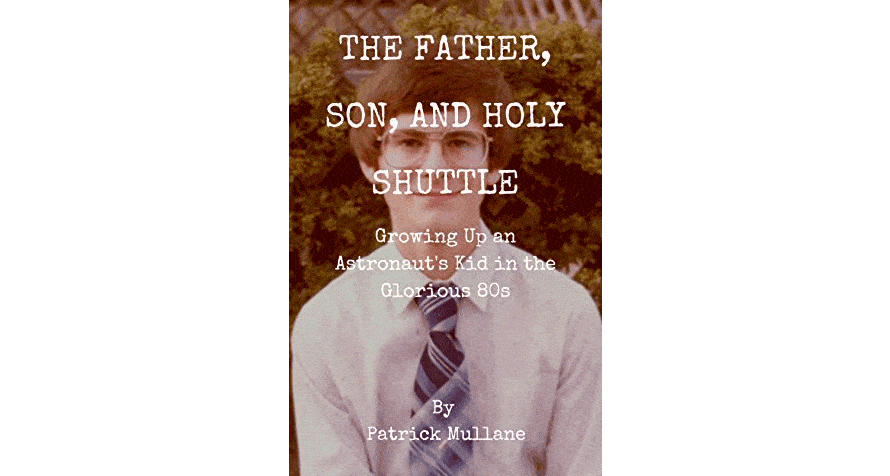Category: Nonfiction
Reviewed by: Mark Lardas
Title: The Father, Son, and Holy Shuttle: Growing Up an Astronaut’s Kid in the Glorious 1980s
Author: Patrick Mullane
NSS Amazon link for this book
Format: Paperback/Kindle
Pages: 271
Publisher: Independently published
Date: April, 2020
Retail Price: $14.99/$3.69
ISBN: 979-8638708986
Between 1978 and 1986 the Space Shuttle program was an adventure. More than that, participating in it was fun. Few people had as good a view of those adventure years as Patrick Mullane, son of Shuttle astronaut Mike Mullane (who also wrote his own book, Riding Rockets).
In The Father, Son, and Holy Shuttle: Growing Up an Astronaut’s Kid in the Glorious 1980s, Patrick Mullane takes readers through his world during eight years in which he was young and the world exciting.
Patrick was ten when his father, Richard “Mike” Mullane was selected as an astronaut in the NASA class of 1978. They called themselves the TFNGs or “Thirty Five New Guys” (Patrick explains that they used an earthier term for the acronym). Patrick had been a military brat. Mike Mullane, a West Point graduate accepted an Air Force commission and flew combat missions in Vietnam before becoming a test pilot. Or rather a test back-seat guy. Mike Mullane was the weapons-systems crewman in two-seat fighter bombers.
The book opens with the first launch attempt of flight 51-D. Patrick then a teen, and other crew families watched as the Shuttle’s main engines started—and then stopped. The sound of engines firing reached the families seconds afterwards, leaving Patrick fearing the Shuttle had just exploded on the launch pad, with is dad aboard. Even after that fear ebbed, as described in a later chapter his father was still trapped aboard the Shuttle until a pad fire was extinguished.
Subsequent chapters describe Patrick’s peripatetic life as a military dependent. He lived in seven homes in eleven years prior to his dad’s astronaut selection, as geographically diverse as Sacramento California and Brampton England. Patrick describes his childhood self as a nerd and aircraft buff. His was probably the best childhood he could have experienced. He had a father who shared his interests and fostered them, and a loving and Catholic family. His father and mother were devoted to each other and to their children, Patrick and his two sisters. Patrick had contact with both sets of grandparents. Patrick relates his family adventure as a combination of the fifties family sitcom Leave it to Beaver and a National Lampoon vacation movie.
The wandering stopped with Mike’s selection as an astronaut candidate (in NASA’s cultural hierarchy one does not become an astronaut until they enter space or die trying). The family settled in the Clear Lake area of Houston, in a subdivision just north of Johnson Space Center. They lived there until 1990 when Mike Mullane left NASA.
Patrick describes his life as an astronaut kid. It was an ordinary life in an extraordinary setting. He went to a factory-sized high school filled with the children of overachievers. Despite his own description of himself as a nerd, he thrived, winning a place on the basketball team in middle school, and becoming a cheerleader and Senior class president in high school.
Patrick expresses the joy he experienced sharing activities with his father, from misadventures with a U-control aircraft to his father teaching him how to fly. He shares his interactions with his father’s colleagues, other astronauts. He also talks about the excitement they shared over his dad’s first flight assignment, Mission 51-D. Patrick helped design the mission’s patch along with the rest of the crew, which included Judy Resnick. He captures the excitement and fun of the early years of the Shuttle program.
A mixture of pride and fear fills his story. Patrick is proud of his dad’s accomplishments, yet fears losing dad to the perils of space. Patrick was in his senior year in high school when Challenger was destroyed, killing the parents of several of his classmates. By then Patrick was focused on college, where he planned to become a pilot for the Air Force.
Occasionally raunchy (what honest memoir of a teenage boy would not be?), The Father, Son, and Holy Shuttle, never gets past PG-13, however. The book is a sweet tale as much about growing up as about the Shuttle program. His description of childhood in the 1970s and 1980s were typical of millions of boys in that period. Today they read as if they occurred in a different age.
© 2020 Mark Lardas
Please use the NSS Amazon Link for all your book and other purchases. It helps NSS and does not cost you a cent! Bookmark this link for ALL your Amazon shopping!



















